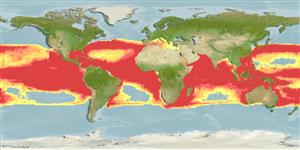Classificação / Names
Common names from other countries
Referência principal
Tamanho / Peso / Idade
Max length : 488 cm TL macho/indeterminado; (Ref. 40637); common length : 350 cm TL macho/indeterminado; (Ref. 5217); Peso máx. publicado: 363.8 kg (Ref. 40637); Idade máx. registada: 20 anos (Ref. 28081)
Length at first maturity
Lm ?, range 154 - 341 cm
Ambiente
; marinhas; oceanódromo (Ref. 51243); intervalo de profundidade 0 - 730 m (Ref. 89423), usually 0 - 100 m (Ref. 43278)
Clima / Intervalo
Subtropical, preferred 27°C (Ref. 107945); 46°N - 40°S, 180°W - 180°E (Ref. 54278)
Distribuição
Descrição breve
Espinhos dorsais (total): 0; Raios dorsais moles (total): 0; Espinhos anais 0; Raios anais moles: 0. A large thresher with very large eyes, an indented forehead, a broad caudal tip, and curved broad-tipped pectoral fins; 1st dorsal fin further back than in other threshers (Ref. 5578). Upper lobe of caudal fin very long and strap-like almost or quite equal to length of rest of shark; lower lobe short but well developed (Ref. 13570). Purplish grey above, cream below, posterior edges of pectoral and pelvic fins and sometimes first dorsal fin dusky; light color of abdomen not expanded over pectoral-fin bases (Ref. 13570).
Categoria na Lista Vermelha da IUCN (Ref. 115185)
Utilização humana
Pescarias: espécies comerciais; peixe desportivo: sim
Mais informação
ReferênciasAquaculturaPerfil para aquaculturaEstirpesGenéticaFrequência dos alelosHereditariedadeDoençasProcessamentoMass conversion
Ferramentas
Relatórios especiais
Descarregue XML
Fontes da internet
Estimates of some properties based on models
Phylogenetic diversity index
PD50 = 0.7500 many relatives (e.g. carps) 0.5 - 2.0 few relatives (e.g. lungfishes)
Nível Trófico
4.5 ±0.0 se; Based on diet studies.
Resiliência
Baixo, tempo mínimo de duplicação da população 4,5 - 14 anos (tm=7; K=0.088; Fec=2-4)
Vulnerabilidade
Very high vulnerability (79 of 100)
Categoria de preço
